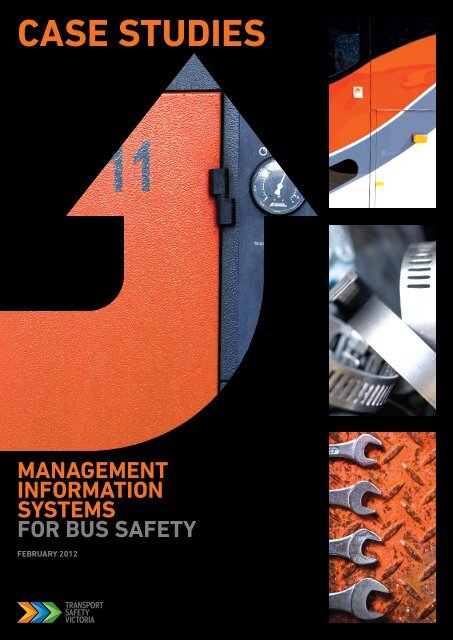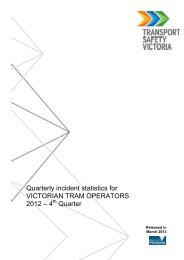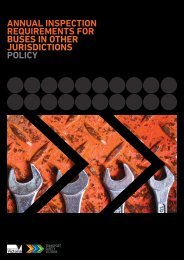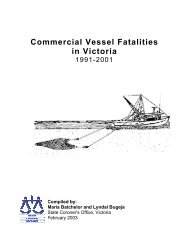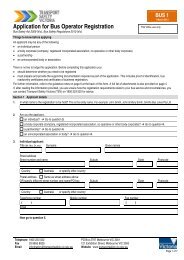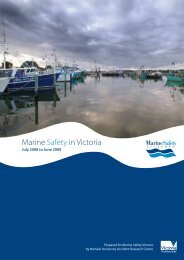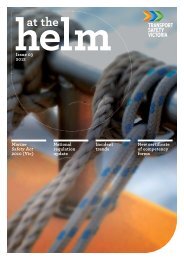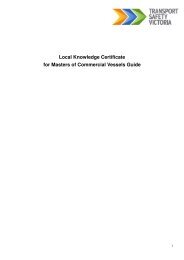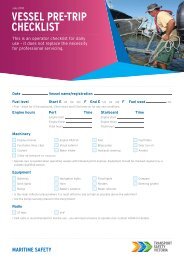Case Study - Management Information Systems - Transport Safety ...
Case Study - Management Information Systems - Transport Safety ...
Case Study - Management Information Systems - Transport Safety ...
Create successful ePaper yourself
Turn your PDF publications into a flip-book with our unique Google optimized e-Paper software.
CASE STUDIES<br />
MANAGEMENT<br />
INFORMATION<br />
SYSTEMS<br />
FOR BUS SAFETY<br />
February 2012<br />
<strong>Case</strong> Studies for <strong>Management</strong> <strong>Information</strong> <strong>Systems</strong> for Bus <strong>Safety</strong> / / 1
Each accredited bus operator must develop its own management information<br />
system based on its own operating conditions, risks, incident history, and<br />
determined safety objectives.<br />
The following case studies are provided as a guide only and are to assist<br />
accredited bus operators develop their own management information system.<br />
The bus operators named in the case studies are fictitious and are used for<br />
illustration purposes only.<br />
This document is intended as a general information source and does not<br />
replace legislation, or limit or expand its scope. While every effort has been<br />
made to ensure that the material is accurate and up to date, the State of Victoria<br />
accepts no responsibility or legal liability for the accuracy or completeness of<br />
the information contained within. Should there be any inconsistency between<br />
these documents and the legislation, the legislation will prevail to the extent of<br />
the inconsistency. It is recommended that you still obtain your own, independent<br />
legal advice about meeting any legislative requirements.<br />
For more information:<br />
Telephone 1800 223 022<br />
Website www.transportsafety.vic.gov.au<br />
Email information@transportsafety.vic.gov.au<br />
2 / / <strong>Case</strong> Studies for <strong>Management</strong> <strong>Information</strong> <strong>Systems</strong> for Bus <strong>Safety</strong>
Contents<br />
1 Introduction 4<br />
1.1 <strong>Case</strong> study organisations 4<br />
2 Matters and information to be contained in the<br />
management information system of an accredited bus operator 4<br />
2.1 Bus safety policy 4<br />
Sample bus safety policy – large operator 6<br />
Sample bus safety policy – small operator 7<br />
2.2 Governance and internal control arrangements 8<br />
2.3 Documented safety accountabilities and authorities 9<br />
Sample job description: depot manager/business owner 10<br />
Sample job description: bus driver 11<br />
Sample job description: mechanic 12<br />
2.4 <strong>Information</strong> management process 13<br />
Sample document register 16<br />
Sample document control form 17<br />
Sample safety records retention schedule 19<br />
Sample fleet register 20<br />
2.5 <strong>Safety</strong> information communication 21<br />
2.6 Drug and alcohol management 22<br />
Sample drug and alcohol management policy – large operator 23<br />
Sample drug and alcohol management policy – small operator 24<br />
2.7 Hazard, risk and change management 25<br />
2.8 Emergency management 25<br />
Sample first response emergency management plan 26<br />
2.9 Bus safety worker competence 27<br />
Sample training matrix 28<br />
Sample record of training 29<br />
Sample driver qualification and training record 30<br />
Sample record of qualifications and competencies 31<br />
2.10 Incident reporting and investigation 32<br />
2.11 Internal audits 33<br />
Sample audit procedure 35<br />
Sample audit scope planner 37<br />
Sample audit log 38<br />
Sample audit checklist and report 39<br />
Sample audit report form 40<br />
Sample non-conformance/non-compliance report 41<br />
2.12 Regulatory compliance (optional) 42<br />
2.13 <strong>Safety</strong> performance targets and performance measures (optional) 42<br />
<strong>Case</strong> Studies for <strong>Management</strong> <strong>Information</strong> <strong>Systems</strong> for Bus <strong>Safety</strong> / / 3
1 // Introduction<br />
To assist you in developing your management information system (MIS), this publication follows two<br />
fictitious bus operators, one large and one small, as they prepare their own MIS. This will highlight what<br />
your processes need to address in order to comply with the new safety regulations.<br />
You are encouraged to read the case studies in order to gain an understanding of the basic requirements<br />
in developing an MIS. You should then rework and cultivate the knowledge to suit your own business<br />
needs. Your MIS needs to be designed to complement and enhance your organisation’s safety culture.<br />
1.1 <strong>Case</strong> study organisations<br />
Our Bus Lines is a prominent operation with 700 employees and 300 vehicles in its fleet. It transports<br />
around 15 million passengers across Victoria each year.<br />
My Bus is a small one-man operation providing public transport to a small regional hub in<br />
Northern Victoria, with a population of 400.<br />
2 // Matters and information to be contained<br />
in the MIS of an accredited bus operator<br />
2.1 Bus safety policy<br />
Our Bus Lines<br />
Our Bus Lines has developed a safety policy which defines the safety aims and objectives of the organisation.<br />
The policy articulates the organisation’s commitment to risk management, the development of a positive<br />
safety culture and continuous safety improvement. The safety policy has been approved by Our Bus Lines’<br />
management team.<br />
The safety policy is reviewed every year by the management team. The review involves consultation with<br />
Our Bus Lines staff and any changes to the policy are submitted to the management team for approval.<br />
The safety policy is a controlled document, requiring the signature of the chief executive officer on behalf<br />
of the management team to take effect.<br />
The safety policy is displayed at various prominent locations around the organisation so it is available to<br />
staff, passengers and the public.<br />
My Bus<br />
Sol Trader, who is the owner/operator of My Bus, has developed a safety policy which defines the safety<br />
aims for his business. The policy articulates his commitment to risk management, the development of a<br />
positive safety culture and continuous safety improvement.<br />
Sol reviews the safety policy every year as part of his business plan review prior to the end of the<br />
financial year.<br />
4 / / <strong>Case</strong> Studies for <strong>Management</strong> <strong>Information</strong> <strong>Systems</strong> for Bus <strong>Safety</strong>
<strong>Case</strong> Studies for <strong>Management</strong> <strong>Information</strong> <strong>Systems</strong> for Bus <strong>Safety</strong> / / 5
Sample Bus <strong>Safety</strong> Policy – large operator<br />
Our Bus Lines is committed to operating in a way that ensures there is minimum risk of injury to<br />
workers, passengers and the general public. The management team is responsible for the safety of the<br />
organisation and shall promote a climate in which all persons are attentive to risks and shall ensure that<br />
controls are in place to reduce risks so far as reasonably practicable.<br />
Our Bus Lines is committed to compliance with the Bus <strong>Safety</strong> Act 2009 (Vic) and Bus <strong>Safety</strong> Regulations<br />
2010 (Vic).<br />
Our Bus Lines will strive to continually improve safety performance levels by:<br />
• identifying and assessing safety risks<br />
• putting in place the controls and resources to reduce risks so far as is reasonably practicable<br />
• making managers and supervisors responsible for implementing the relevant sections of the MIS and<br />
maintenance management system (MMS), and for developing standards and procedures for employees<br />
• ensuring that all workers are trained in these standards and procedures and are committed to the Our<br />
Bus Lines safety policy and the safety of others<br />
• monitoring and auditing against this safety policy and compliance with the MIS and MMS.<br />
Suggestions from the staff about how safety can be improved will always be appreciated and encouraged<br />
within Our Bus Lines.<br />
Our Bus Lines has identified key safety performance targets to monitor the performance of this<br />
organisation, including:<br />
• injuries<br />
• defect reports<br />
• customer complaints.<br />
Signed<br />
CEO, Our Bus Lines<br />
On behalf of the management team<br />
1 January 2011<br />
Each operator will need to develop a safety policy based on its specific operating conditions, risks,<br />
incident history and determined safety objectives.<br />
6 / / <strong>Case</strong> Studies for <strong>Management</strong> <strong>Information</strong> <strong>Systems</strong> for Bus <strong>Safety</strong>
Sample Bus <strong>Safety</strong> Policy – small operator<br />
My Bus is committed to operating in a way that ensures there is minimum risk of injury to workers,<br />
passengers and the general public. As the owner and sole employee, I am responsible for the safety<br />
of the organisation. I will promote a climate in which all people are attentive to risks to safety and I will<br />
ensure that the appropriate controls are in place to reduce risks to safety so far as reasonably practicable.<br />
My Bus is committed to compliance with the Bus <strong>Safety</strong> Act 2009 (Vic) and Bus <strong>Safety</strong> Regulations 2010 (Vic).<br />
My Bus will strive to continually improve safety performance levels by:<br />
1. identifying and assessing safety risks<br />
2. putting in place the controls and resources to reduce risks so far as is reasonably practicable<br />
3. monitoring and auditing against this safety policy and compliance with the MIS and MMS.<br />
Suggestions about how safety can be improved will always be appreciated and encouraged within My Bus.<br />
My Bus has identified key safety performance targets to monitor the performance of this organisation,<br />
including:<br />
• injuries<br />
• defect reports<br />
• customer complaints.<br />
Signed<br />
Owner, My Bus<br />
1 November 2010<br />
Each operator will need to develop a safety policy based on its specific operating conditions, risks,<br />
incident history and determined safety objectives.<br />
<strong>Case</strong> Studies for <strong>Management</strong> <strong>Information</strong> <strong>Systems</strong> for Bus <strong>Safety</strong> / / 7
2.2 Governance and internal control arrangements<br />
Our Bus Lines<br />
Governance<br />
The management team of Our Bus Lines is made up of the following positions:<br />
• chief executive officer (CEO)<br />
• manager<br />
• supervisor.<br />
The management team is elected annually at the Our Bus Lines annual general meeting.<br />
The management team reviews its standards and procedures on a regular basis at its monthly meetings<br />
in order to monitor the effectiveness of document control processes as well as other issues.<br />
Another standard agenda item at the committee meetings is the review of the risk register. The supervisor<br />
provides an update on the risk register at each meeting and aspects of the risk register are discussed by<br />
the management team.<br />
The manager provides the CEO and management team with appropriate safety information to assist them<br />
in their decision making.<br />
The management team is provided with copies of internal audits to give them sufficient knowledge about<br />
the level of compliance displayed by the organisation.<br />
Internal control arrangements<br />
The responsibility for implementing and maintaining the MIS at Our Bus Lines has been given<br />
to the manager.<br />
The overall management of operational safety is the responsibility of the supervisor, who has<br />
responsibility for applying risk management processes to maintain a safe operational and work<br />
environment.<br />
The major safety responsibilities and accountabilities within Our Bus Lines are set out in individual<br />
job descriptions.<br />
My Bus<br />
Sol Trader has completed a training course approved by the <strong>Safety</strong> Director and reviews the risk register<br />
he has developed as part of his overall business review, completed at the end of each financial year.<br />
Sol will also review the risk register if he introduces any material change into his business.<br />
Sol completes his own internal audits of his business to test compliance with applicable legislation and<br />
his own procedures.<br />
8 / / <strong>Case</strong> Studies for <strong>Management</strong> <strong>Information</strong> <strong>Systems</strong> for Bus <strong>Safety</strong>
2.3 Documented safety accountabilities and authorities<br />
Our Bus Lines<br />
Our Bus Lines has documented the job descriptions and safety relevant responsibilities for all job functions<br />
that complete bus safety work and had the position holder sign the document to signify they have read and<br />
understood their obligations. The manager of Our Bus Lines then holds the signed job descriptions on file.<br />
Our Bus Lines has developed job descriptions for depot managers, drivers and mechanics.<br />
My Bus<br />
Given that Sol Trader has no employees and runs the business himself, he keeps his Certificate<br />
of Accreditation as evidence of his sole accountability for the safety of his operation.<br />
Sol outsources the maintenance of his bus to a local mechanic. Sol advised the mechanic in writing of his<br />
safety obligation to maintain My Bus buses in accordance with the requirements of the My Bus MIS and<br />
MMS and provided the mechanic with copies.<br />
Sol has obtained a letter from the mechanic which confirms that the mechanic is aware of his obligations.<br />
<strong>Case</strong> Studies for <strong>Management</strong> <strong>Information</strong> <strong>Systems</strong> for Bus <strong>Safety</strong> / / 9
Sample job description: depot manager/business owner<br />
Job purpose:<br />
The depot manager has overall responsibility for ensuring the bus service runs safely and for the<br />
implementation and monitoring of the organisation’s safety management system.<br />
To fulfill their safety responsibilities, depot managers:<br />
• provide leadership on safety issues<br />
• manage operations and staff to ensure that services are provided in a safe manner<br />
• integrate safety requirements into the position descriptions, performance agreements and<br />
work plans of staff<br />
• ensure effective communication processes are implemented across all functional areas<br />
• involve staff in the development of safe work practices<br />
• encourage staff to be aware of unsafe activities and to participate in identifying unsafe areas,<br />
including ideas about improvements and training<br />
• ensure that information on safety issues is regularly communicated to staff<br />
• ensure hazard management systems are in place and regularly reviewed and updated<br />
• ensure staff are provided with the training and resources necessary to carry out their<br />
responsibilities safely<br />
• monitor the performance of drivers and other staff to ensure duties are performed in a<br />
safe and professional manner<br />
• report and, where appropriate, investigate incidents<br />
• evaluate and audit operational and safety systems on a regular basis.<br />
I _ _________________________________________ have read and received instruction on the above<br />
job description and agree to abide by the responsibilities outlined.<br />
Signature __________________________________ Date_ ______________________<br />
10 / / <strong>Case</strong> Studies for <strong>Management</strong> <strong>Information</strong> <strong>Systems</strong> for Bus <strong>Safety</strong>
Sample job description: bus driver<br />
Job purpose:<br />
Drivers are responsible for operating buses in a manner which ensures the safety of themselves,<br />
their passengers and the public and in accordance with all safety relevant legislation and<br />
organisational requirements.<br />
To fulfil their safety responsibilities bus drivers:<br />
• ensure the safety of passengers<br />
• operate buses in accordance with relevant road laws, other applicable legislation and company policies<br />
• advise the accredited bus operator of any safety issues discovered during the operation of the bus<br />
• report all incidents and injuries, including completing accident report forms and incident reports, as required<br />
• complete vehicle pre-departure checks<br />
• report any damage, defect or repairs needed to the bus<br />
• do not have any alcohol or drugs present in their blood or breath immediately before, or while, driving a bus<br />
• immediately report any matters relevant to the currency of their driver’s licence or driver authority,<br />
including details of any criminal charges or offences<br />
• immediately report all health issues or other issues that may affect their fitness to drive<br />
• follow policies, procedures and safety instructions<br />
• wear all personal protective equipment (PPE) as issued by the operator<br />
• participate in training and staff meetings as required.<br />
I _ _________________________________________ have read and received instruction on the above<br />
job description and agree to abide by the responsibilities outlined.<br />
Signature __________________________________ Date_ ______________________<br />
<strong>Case</strong> Studies for <strong>Management</strong> <strong>Information</strong> <strong>Systems</strong> for Bus <strong>Safety</strong> / / 11
Sample job description: mechanic<br />
Job purpose:<br />
Workshop mechanics are responsible for carrying out maintenance and repair to a level that ensures bus<br />
safety and roadworthiness.<br />
To fulfil their responsibilities mechanics:<br />
• undertake day to day bus repair and maintenance activities to ensure vehicle safety<br />
and roadworthiness<br />
• fulfil vehicle preventative maintenance schedules and requirements<br />
• maintain vehicle monitoring and reporting systems as required by relevant authorities<br />
• respond to, investigate and repair vehicle defects as notified by drivers in vehicle defect books<br />
• maintain a safe workshop area<br />
• work in accordance with safe working procedures and instructions and comply with the accredited<br />
bus operator’s MIS<br />
• do not have any alcohol or drugs present in their blood or breath immediately before, or while,<br />
performing bus safety work<br />
• report all health issues or other issues that may affect their fitness to work<br />
• follow policies, procedures and safety instructions<br />
• wear all PPE as issued by the operator or pertinent to the job<br />
• participate in training and staff meetings as required.<br />
I _ _________________________________________ have read and received instruction on the above<br />
job description and agree to abide by the responsibilities outlined.<br />
Signature __________________________________ Date_ ______________________<br />
12 / / <strong>Case</strong> Studies for <strong>Management</strong> <strong>Information</strong> <strong>Systems</strong> for Bus <strong>Safety</strong>
2.4 <strong>Information</strong> management process<br />
Our Bus Lines<br />
(a) Document identification<br />
The identification and administration of safety records will be the responsibility of the Our Bus Lines<br />
manager and the relevant supervisors. A ‘bus safety record’ is a document that outlines the day to day<br />
operations of the accredited bus operator. This includes operational records, engineering records and<br />
bus safety worker records such as training records.<br />
Controlled documents are allocated a unique identification number. Where there is more than one copy<br />
of a controlled document these are numbered in sequence.<br />
(b) Document registration and storage<br />
A document register is kept in the manager’s office and includes the following information as a minimum:<br />
• unique document number<br />
• title of document, standard, procedure or form<br />
• person responsible for maintaining document<br />
• issue date<br />
• document status, for example, draft, revision number, superseded or obsolete<br />
• risk register cross reference, where appropriate<br />
• retention period<br />
• disposal protocol.<br />
Our Bus Lines makes safety records available for inspection by authorised parties as required.<br />
The safety records retention schedule lists the records to be retained, how long these are to be retained<br />
and the name of the manager or supervisor who is responsible for monitoring storage and retention.<br />
Hard copy records are kept in the manager’s office for the required period and then either retained or<br />
destroyed and the safety records retention schedule updated accordingly. Documents are securely stored<br />
to guard against the risk of loss through deterioration or damage.<br />
Electronic records are backed up. Back-up records are kept secure at a location remote from the main<br />
office where the master records are kept.<br />
<strong>Case</strong> Studies for <strong>Management</strong> <strong>Information</strong> <strong>Systems</strong> for Bus <strong>Safety</strong> / / 13
(c) Document and data approval and issue<br />
The manager of Our Bus Lines reviews and approves all new and amended bus safety documents before<br />
they are issued.<br />
The manager records that review and approval has taken place by signing the relevant column of the<br />
document control form at the front of each master control document.<br />
The identity of individual holders of manuals and procedures is recorded on the document control form at<br />
the front of each controlled master copy.<br />
The manager distributes controlled documents by hand to each person on the document distribution list<br />
for storage in agreed locations, for example, workshop, company office. The manager removes obsolete<br />
documents and then updates the document register to indicate the current status of each document.<br />
Archived or superseded documents that could impact on the safe operations of Our Bus Lines are stored<br />
separately in a secure environment.<br />
Our Bus Lines retains documents in accordance with the safety records retention schedule, after which<br />
they are reviewed and either discarded or retained as archival documents.<br />
(d) Document changes<br />
The relevant supervisors are responsible for issuing any amendments to the documents for which they<br />
have responsibility to the manager for inclusion in controlled manuals and for distribution to workers<br />
as appropriate.<br />
Amendments to documents are identified by the inclusion of a vertical line in the margin against each<br />
paragraph containing current changes in the revised version. When subsequent amendments are required<br />
the vertical lines against the previous amendments are deleted and new vertical lines included against the<br />
current changes.<br />
Any amendments to bus safety documents are reviewed and approved by the management team.<br />
14 / / <strong>Case</strong> Studies for <strong>Management</strong> <strong>Information</strong> <strong>Systems</strong> for Bus <strong>Safety</strong>
My Bus<br />
Sol Trader has produced only two copies of his MIS and MMS. Copy number one is for his use and copy<br />
number two is provided to the mechanic who maintains his bus.<br />
Any safety relevant records are kept in an alphabetical vertical file held by Sol.<br />
(a) Document identification<br />
The identification and administration of safety records will be the responsibility of the owner/accredited<br />
bus operator.<br />
A bus safety record is a document that outlines the day to day operations of the operator. It includes<br />
operational records, engineering records and bus safety worker records, such as competencies and<br />
training records.<br />
(b) Document registration and storage<br />
My Bus makes safety records available for inspection by authorised parties as required.<br />
The safety records retention schedule lists the records to be retained, how long these are to be retained<br />
and the name of the manager or supervisor who is responsible for monitoring storage and retention.<br />
Hard copy records are kept in the accredited bus operator’s office for the required period and then either<br />
retained or destroyed and the safety records retention schedule updated accordingly. Documents are<br />
securely stored to guard against the risk of loss through deterioration or damage.<br />
Electronic records are backed up. Back-up records are kept secure at a location remote from the main<br />
office where the master records are kept.<br />
<strong>Case</strong> Studies for <strong>Management</strong> <strong>Information</strong> <strong>Systems</strong> for Bus <strong>Safety</strong> / / 15
Sample document register<br />
Document<br />
number<br />
Document<br />
title<br />
Person<br />
responsible<br />
for<br />
maintaining<br />
document<br />
Issue<br />
date<br />
Current status<br />
(draft, current,<br />
archived, destroyed)<br />
Risk register<br />
crossreference<br />
Retention<br />
period<br />
Date<br />
withdrawn/<br />
disposal<br />
action<br />
16 / / <strong>Case</strong> Studies for <strong>Management</strong> <strong>Information</strong> <strong>Systems</strong> for Bus <strong>Safety</strong>
Sample document control form<br />
1. Document Status Record<br />
Status Date Issue revision Prepared by<br />
(signature)<br />
Reviewed and<br />
approved by<br />
(signature)<br />
Document<br />
owner<br />
Draft<br />
Rev.0<br />
<strong>Case</strong> Studies for <strong>Management</strong> <strong>Information</strong> <strong>Systems</strong> for Bus <strong>Safety</strong> / / 17
2. Document Distribution List<br />
Position Organisation Copy issued<br />
(Yes/No)<br />
Copy number<br />
Master copy (manager) Our Bus Lines Yes 1<br />
List the positions/people who<br />
receive copies<br />
Operations supervisor Our Bus Lines Yes 2<br />
Supervisor Our Bus Lines Yes 3<br />
Mechanic Dave’s Garage Yes 4<br />
18 / / <strong>Case</strong> Studies for <strong>Management</strong> <strong>Information</strong> <strong>Systems</strong> for Bus <strong>Safety</strong>
Sample safety records retention schedule<br />
Title of safety record<br />
Retention<br />
period<br />
Location<br />
of record<br />
Position<br />
responsible<br />
for removal<br />
Disposal<br />
method<br />
Comments<br />
List the records kept<br />
by your organisation<br />
<strong>Management</strong> review<br />
meeting minutes<br />
Internal audit records<br />
Third party audits<br />
Accident/incident<br />
notification of occurrences<br />
Accident/incident<br />
investigation reports<br />
Incident trend and<br />
analysis reports<br />
Staff competency records<br />
Staff medical reports<br />
Staff training records<br />
Regulatory reports<br />
Contract records<br />
Calibration sheets<br />
and certificates<br />
Risk assessment records<br />
<strong>Case</strong> Studies for <strong>Management</strong> <strong>Information</strong> <strong>Systems</strong> for Bus <strong>Safety</strong> / / 19
Sample fleet register<br />
Fleet Register<br />
Fleet number<br />
Registration<br />
number<br />
Expiry<br />
date<br />
Year of<br />
manufacture<br />
Chassis<br />
make<br />
Carrying<br />
capacity<br />
20 / / <strong>Case</strong> Studies for <strong>Management</strong> <strong>Information</strong> <strong>Systems</strong> for Bus <strong>Safety</strong>
2.5 <strong>Safety</strong> information communication<br />
Our Bus Lines<br />
Our Bus Lines recognises the importance of providing personnel with the necessary information to enable<br />
them to discharge their safety responsibilities effectively.<br />
To ensure the timely and effective communication of safety related information Our Bus Lines:<br />
• holds regular management team meetings and circulates the meeting minutes to all personnel<br />
• ensures that controlled copies of the MIS and all procedures and standards are readily accessible<br />
to personnel at relevant places throughout the business<br />
• regularly disseminates safety related information through regular newsletters<br />
• circulates safety bulletins to all operational staff when particular safety issues are identified,<br />
which may require an acknowledgement receipt to be returned<br />
• uses electronic media, such as emails and the organisation’s website, to disseminate information.<br />
Each Our Bus Lines worksite area has an official noticeboard on which the Our Bus Lines <strong>Safety</strong> Policy and<br />
other key safety notices are displayed. All staff are required to check the noticeboard and where required,<br />
to initial the notice to indicate that they have read it.<br />
My Bus<br />
My Bus recognises the importance of giving service providers the necessary information to enable them<br />
to discharge their safety responsibilities effectively.<br />
To ensure the timely and effective communication of safety related information<br />
the accredited bus operator:<br />
• holds meetings as required with service providers to provide updated safety information<br />
• ensures that controlled copies of the MIS are readily accessible to persons acting for or on behalf of My Bus.<br />
<strong>Case</strong> Studies for <strong>Management</strong> <strong>Information</strong> <strong>Systems</strong> for Bus <strong>Safety</strong> / / 21
2.6 Drug and alcohol management<br />
Our Bus Lines<br />
Drugs and alcohol<br />
The Our Bus Lines Drug and Alcohol <strong>Management</strong> Policy prohibits any person who is affected by drugs<br />
or alcohol from taking any part in bus safety work.<br />
Personnel are required to advise their supervisors if taking any medication which may affect performance.<br />
Our Bus Lines managers rely on visual and verbal assessments to form a reasonable impression as to<br />
whether a person’s behaviour is affected by drugs or alcohol.<br />
Where necessary, to determine whether a person is affected by alcohol, a breath test and/or breath<br />
analysis may be arranged with the local police. In these cases the supervisor must refer the matter to the<br />
manager, who has responsibility for making the final decision.<br />
A person may wish to challenge the decision which prevents them from taking part in Our Bus Lines<br />
operations due to the belief they are affected by drugs. To do this, the person must be referred to a<br />
qualified medical practitioner for drug urine analysis.<br />
Our Bus Lines has arrangements with local police and a local testing service provider to undertake postincident<br />
drug and alcohol testing on an as-required basis.<br />
My Bus<br />
Drugs and alcohol<br />
The My Bus Drug and Alcohol <strong>Management</strong> Policy prohibits any person who is affected by drugs or alcohol<br />
from taking any part in bus safety work.<br />
Sol Trader will ensure he does not operate his bus while taking any medication which may affect his<br />
performance.<br />
22 / / <strong>Case</strong> Studies for <strong>Management</strong> <strong>Information</strong> <strong>Systems</strong> for Bus <strong>Safety</strong>
Sample drug and alcohol management policy – large operator<br />
An accredited bus operator must develop its drug and alcohol management policy in consultation with bus<br />
safety workers who are employees or contractors of the operator.<br />
This sample policy does not include testing procedures. If the drug and alcohol management policy<br />
provides for testing procedures, such procedures must comply with section 57(2) of the Bus <strong>Safety</strong> Act.<br />
Our Bus Lines Drug and Alcohol Policy<br />
Our Bus Lines is committed to a zero tolerance alcohol and illicit drugs working environment. It will take<br />
all practicable steps to endeavour that all persons performing bus safety work have a zero level of alcohol<br />
and illicit drugs and are not impaired by other drugs.<br />
Our Bus Lines has adopted this policy because of its general duty:<br />
• to provide a safe and healthy work environment<br />
• to ensure that all persons are fit to carry out their duties.<br />
Our Bus Lines recognises the detrimental effects that drugs and alcohol may have on the safety of bus<br />
operations and the general health and wellbeing of individuals.<br />
This policy applies to all persons carrying out bus safety work, as defined in section 3 of the Bus <strong>Safety</strong> Act<br />
2009 (Vic), for or on behalf of Our Bus Lines. If you are unclear about what constitutes bus safety work, see<br />
your manager.<br />
It is the responsibility of every person when reporting for duty or while at work to ensure they:<br />
• have no drugs or alcohol present in their blood or breath immediately before, or while undertaking bus<br />
safety work<br />
• are not impaired by drugs or medication/s immediately before, or while, undertaking bus safety work<br />
• inform their treating health practitioner or pharmacist of the Our Bus Lines Drug and Alcohol<br />
<strong>Management</strong> Policy when being prescribed medications.<br />
Signed<br />
Chief Executive Officer<br />
On behalf of the Our Bus Lines Committee of <strong>Management</strong><br />
Date / /2011<br />
<strong>Case</strong> Studies for <strong>Management</strong> <strong>Information</strong> <strong>Systems</strong> for Bus <strong>Safety</strong> / / 23
Sample drug and alcohol management policy – small operator<br />
An accredited bus operator must develop its drug and alcohol management policy in consultation with bus<br />
safety workers, who are employees or contractors of the operator.<br />
This sample policy does not include testing procedures. If the Drug and Alcohol <strong>Management</strong> Policy<br />
provides for testing procedures, such procedures must comply with section 57(2) of the Bus <strong>Safety</strong> Act.<br />
My Bus Drug and Alcohol Policy<br />
My Bus is committed to a zero tolerance alcohol and illicit drugs working environment. It will take all<br />
practicable steps to endeavour that all persons performing bus safety work have a zero level for alcohol<br />
and illicit drugs and are not impaired by other drugs.<br />
As the sole operator and employee of My Bus, I recognise the detrimental effects that drugs and alcohol<br />
may have on the safety of bus operations and the general health and wellbeing of individuals.<br />
I will ensure that every time I undertake bus safety work, as defined under section 3 of the Bus <strong>Safety</strong> Act<br />
2009 (Vic):<br />
• I will have no drugs or alcohol present in my blood or breath immediately before, or while undertaking<br />
bus safety work<br />
• I am not impaired by drugs or medication/s<br />
• I will inform my treating health practitioner or pharmacist of my policy when being prescribed<br />
medications.<br />
This policy will be communicated to the following persons, or companies, who perform bus safety work<br />
for or on behalf of My Bus:<br />
1. Dave’s Garage, who performs mechanical work on My Bus vehicles.<br />
2. XYZ<br />
3. ABC<br />
Complete as necessary<br />
Signed<br />
Owner, My Bus<br />
Date / /2011<br />
24 / / <strong>Case</strong> Studies for <strong>Management</strong> <strong>Information</strong> <strong>Systems</strong> for Bus <strong>Safety</strong>
2.7 Hazard, risk and change management<br />
Our Bus Lines<br />
The concepts of the <strong>Transport</strong> <strong>Safety</strong> Victoria (TSV) guidance material on managing safety so far as is<br />
reasonably practicable, issued by the <strong>Safety</strong> Director, have been applied to Our Bus Lines operating<br />
environment.<br />
My Bus<br />
The concepts of the TSV guidance material on managing safety so far as is reasonably practicable, issued<br />
by the <strong>Safety</strong> Director, have been applied to the Sol Trader operating environment.<br />
2.8 Emergency management<br />
Our Bus Lines<br />
The manager of Our Bus Lines uses a First Response Emergency <strong>Management</strong> Plan which is held on each<br />
bus to provide drivers with instructions and contact numbers to be used in the event of an emergency.<br />
The Our Bus Lines Emergency Planning Committee will review the emergency plan annually, in<br />
conjunction with the emergency services and government agencies.<br />
My Bus<br />
Sol Trader uses a First Response Emergency <strong>Management</strong> Plan which is held on his bus to provide him<br />
with instructions and contact numbers to be used in the event of an emergency.<br />
Sol Trader ensures the currency of the emergency plan by reviewing the numbers annually, as part of his<br />
internal audit program.<br />
<strong>Case</strong> Studies for <strong>Management</strong> <strong>Information</strong> <strong>Systems</strong> for Bus <strong>Safety</strong> / / 25
Sample first response emergency management plan<br />
The responsible person will ensure that emergency information is available in each bus. This form assigns<br />
responsibilities and authorities to all staff and must be consulted in the case of an emergency or accident.<br />
The contact list, codes and procedures for communication must be followed and anyone becoming aware<br />
of any changes needed should immediately contact management.<br />
Emergency <strong>Management</strong> Plan – Instructions to drivers<br />
Emergency contacts:<br />
In the case of any emergency you should immediately contact the appropriate emergency services.<br />
The depot/owner should also be contacted and advised as to the event.<br />
Police – Ambulance – Fire Dial “000”<br />
Have the following information available when contacting emergency services:<br />
• nature of the emergency<br />
• number and nature of injuries (if applicable)<br />
• your location (the more exact, the quicker the response)<br />
• hazards which may exist for rescue personnel attending<br />
• bus owner’s contact details<br />
• the telephone number you are calling from<br />
• your assessment of the situation.<br />
Local contact numbers<br />
Local CFA:<br />
Local SES:<br />
School bus co-ordinator:<br />
Depot:<br />
Additional considerations:<br />
• your first priority is the safety of your passengers – all other actions take second place to this priority<br />
• assess the situation and, should an evacuation of the bus be required, use the most appropriate method/exit, remain<br />
calm, speak slowly and clearly, direct passengers to safest off-vehicle location<br />
• keep passengers informed of the progress of any action to be taken, for example, details such as ETA of fire/ambulance,<br />
ETA of replacement bus<br />
• where possible, remain with the passengers and only leave them to seek assistance as a last resort<br />
• if appropriate, render first aid treatment and delegate tasks, for example, head counts, protection of the scene,<br />
to responsible passengers<br />
• if there is danger – do not re-board the bus to obtain property.<br />
Unforeseen events:<br />
For situations such as bushfire, flood, items across roadway you should always follow the instructions of local police/ CFA/<br />
emergency services. If emergency services personnel require you to travel off your normal route, this information should<br />
be relayed to the owner/depot.<br />
Must be modified by the bus operator after operational risks are assessed.<br />
26 / / <strong>Case</strong> Studies for <strong>Management</strong> <strong>Information</strong> <strong>Systems</strong> for Bus <strong>Safety</strong>
2.9 Bus safety worker competence<br />
Our Bus Lines<br />
Our Bus Lines management team develops and regularly reviews position descriptions for all bus safety<br />
work. These reviews identify the competencies deemed necessary to ensure that persons undertaking the<br />
bus safety work have the knowledge, skills and experience to carry out their duties in a safe manner.<br />
All Our Bus Lines personnel hold safety qualifications and/or competencies appropriate for their<br />
positions and are regularly assessed for necessary competencies related to their work responsibilities.<br />
Competencies and training requirements for bus safety workers are detailed in the training matrix with<br />
courseware, training materials, and assessment materials located in the training resources folder.<br />
Competency assessments are organised by the relevant managers and whenever possible, assessments<br />
are carried out using a registered training organisation. In cases where there is no appropriate course<br />
available, assessments are carried out by people within the organisation who have qualifications and /or<br />
experience in the field of expertise being assessed.<br />
Records of training and records of qualifications and competencies are held in personnel files in a<br />
secure location.<br />
My Bus<br />
Sol Trader has completed an approved training course and has his certificate of accreditation as evidence<br />
of his competence and capacity to operate a bus service safely.<br />
<strong>Case</strong> Studies for <strong>Management</strong> <strong>Information</strong> <strong>Systems</strong> for Bus <strong>Safety</strong> / / 27
Sample Training Matrix<br />
Position Skill Method By when Method of<br />
assessment<br />
Review<br />
Manager <strong>Management</strong> skills Course, recognition of prior<br />
learning, or recognition of<br />
prior experience<br />
Prior to<br />
appointment<br />
Interview<br />
Annual<br />
performance<br />
review<br />
Occupational health<br />
and safety<br />
Course, recognition of prior<br />
learning, or recognition of<br />
prior experience<br />
Within<br />
six months<br />
By course from<br />
external provider<br />
Three yearly<br />
refresher<br />
First aid training Course Within<br />
six months<br />
By course from<br />
external provider<br />
Three yearly<br />
refresher<br />
Customer service<br />
and grooming<br />
Course, recognition of prior<br />
learning, or recognition of<br />
prior experience<br />
Prior to<br />
appointment<br />
By course from<br />
external provider<br />
Annual<br />
performance<br />
review<br />
Duty<br />
manager<br />
Ticketing<br />
Course, recognition of prior<br />
learning, or recognition of<br />
prior experience<br />
Prior to<br />
appointment<br />
Internal course<br />
Annual<br />
performance<br />
review<br />
Handling money<br />
and balancing cash,<br />
supervisor skills<br />
Course, recognition of prior<br />
learning, or recognition of<br />
prior experience<br />
Prior to<br />
appointment<br />
Internal course<br />
Annual<br />
performance<br />
review<br />
Occupational<br />
health and safety<br />
knowledge<br />
Course, recognition of prior<br />
learning, or recognition of<br />
prior experience<br />
Within<br />
six months<br />
By course from<br />
external provider<br />
Three yearly<br />
refresher<br />
First aid training Course Within<br />
six months<br />
By course from<br />
external provider<br />
Three yearly<br />
refresher<br />
Mechanic Trade skills Trade training, recognition of<br />
prior learning or recognition<br />
of prior experience<br />
Prior to<br />
appointment<br />
By certificate<br />
Annual<br />
performance<br />
review<br />
Occupational<br />
health and safety<br />
knowledge<br />
Course, recognition of prior<br />
learning, or recognition of<br />
prior experience<br />
Within<br />
six months<br />
By course from<br />
external provider<br />
Three yearly<br />
refresher<br />
First aid training Course Within<br />
six months<br />
By course from<br />
external provider<br />
Three yearly<br />
refresher<br />
28 / / <strong>Case</strong> Studies for <strong>Management</strong> <strong>Information</strong> <strong>Systems</strong> for Bus <strong>Safety</strong>
Sample record of training<br />
Date Course Assessment result Expiry date of<br />
assessment<br />
Comments (including<br />
relevance to positions)<br />
<strong>Case</strong> Studies for <strong>Management</strong> <strong>Information</strong> <strong>Systems</strong> for Bus <strong>Safety</strong> / / 29
Sample driver qualification and training record<br />
Name of employee<br />
Driver’s licence number<br />
Driver’s licence category<br />
Driver’s accreditation number<br />
Hazardous area authority<br />
Expiry date<br />
Employment<br />
commencement date<br />
Expiry date<br />
Expiry date<br />
Additional qualifications<br />
or certificates<br />
Provider Qualification Number<br />
Awareness requirements<br />
Date<br />
Employee signature<br />
Bus operations/standards<br />
and regulations<br />
Daily vehicle inspection<br />
Vehicle defect reporting<br />
Work diary and driving hours requirements<br />
Emergency procedures<br />
Completion of awareness training date<br />
Checked by Date: Review date<br />
Comments<br />
30 / / <strong>Case</strong> Studies for <strong>Management</strong> <strong>Information</strong> <strong>Systems</strong> for Bus <strong>Safety</strong>
Sample record of qualifications and competencies<br />
Name<br />
Position(s)<br />
Date Qualification or competency Expiry date of<br />
qualification or<br />
competency<br />
Comments<br />
(including relevance<br />
to positions)<br />
<strong>Case</strong> Studies for <strong>Management</strong> <strong>Information</strong> <strong>Systems</strong> for Bus <strong>Safety</strong> / / 31
2.10 Incident reporting and investigation<br />
Our Bus Lines<br />
The manager of Our Bus Lines is nominated as the person to advise TSV of bus safety incidents and has<br />
entered the TSV duty officer contact number in his mobile telephone.<br />
The manager has familiarised himself with the reporting criteria, as described in the Bus <strong>Safety</strong> Regulations<br />
2010 (Vic) and printed a copy of the relevant section, which he keeps in a folder in his briefcase.<br />
He has produced a bullet point checklist which describes what he must do should an incident occur and<br />
placed this in the folder.<br />
He has also printed a small stock of TSV incident report forms, downloaded from its website, and keeps<br />
them in the folder.<br />
When the manager takes leave, he delegates the reporting responsibility to his assistant manager and<br />
gives him/her the folder.<br />
My Bus<br />
Sol Trader is the person to advise TSV of bus safety incidents and has entered the TSV duty officer contact<br />
number in his mobile telephone.<br />
He has familiarised himself with reporting criteria, as described in the bus safety regulations and printed<br />
a copy of the relevant section, which he keeps in a folder in his briefcase.<br />
He has produced a bullet point checklist which describes what he must do should an incident occur and<br />
placed this in the folder.<br />
He has also printed a small stock of TSV incident report forms, downloaded from the its website, and<br />
keeps them in the folder.<br />
The bus service does not operate when Sol Trader takes leave, so he has not delegated the<br />
reporting obligation.<br />
32 / / <strong>Case</strong> Studies for <strong>Management</strong> <strong>Information</strong> <strong>Systems</strong> for Bus <strong>Safety</strong>
2.11 Internal audits<br />
Our Bus Lines<br />
(a) <strong>Safety</strong> audit program<br />
The Our Bus Lines management committee is responsible for establishing and managing the annual<br />
audit program. Two levels of auditing may be undertaken:<br />
1. Our Bus Lines’ workers with relevant experience and knowledge of position responsibilities, but<br />
independent of the position being audited, carry out internal audits to ensure individuals who are<br />
assigned safety responsibilities are effectively carrying out their responsibilities.<br />
2. Where appropriate, external auditors with relevant experience may carry out audits of specific<br />
MIS policies and procedures.<br />
Audits are conducted according to the audit procedure.<br />
The manager is responsible for internal audit arrangements and for reviewing the risk register to<br />
make sure high risks are given priority.<br />
(b) Audit scheduling<br />
The management team prioritises the audit program, taking into account various factors, including:<br />
• previous audit findings and recommendations<br />
• recent safety performance<br />
• status and importance of activities to be audited<br />
• scope of previous audit<br />
• industry trends.<br />
The program is run on a financial year basis according to a prepared audit scope planner. This schedule<br />
may vary as a result of changes to audit priorities or if additional audit requirements are identified.<br />
The audit schedule makes provision for all safety related activities to be audited at least once during<br />
every financial year.<br />
The audit program is monitored at meetings of the management team, which inspects the audit log to<br />
ensure audits are proceeding according to schedule. Annual audits are conducted to ensure the entire<br />
MIS is reviewed every year.<br />
(c) Audit reporting<br />
Audit findings are initially documented on an audit checklist and report form before being finalised on<br />
the audit report form with non-conformance/non-compliance report forms completed, as necessary.<br />
The scope for annual independent audits includes the requirement to provide a written audit report.<br />
Audit reports are given to the manager and are reviewed at management team meetings until all<br />
corrective action items have been completed.<br />
Where findings from audits require urgent attention the manager can assign corrective action items to<br />
the relevant workers or arrange to convene a management team meeting to review the findings and<br />
assign action.<br />
<strong>Case</strong> Studies for <strong>Management</strong> <strong>Information</strong> <strong>Systems</strong> for Bus <strong>Safety</strong> / / 33
My Bus<br />
Sol Trader has developed a checklist utilising some components from the TSV checklist, used as part of its<br />
accreditation process of his operation, and adapted it for his business needs.<br />
Sol uses this checklist to conduct annual internal audits of his operations and records any areas of<br />
non-compliance and the corrective action taken to address the non-compliance on the checklist.<br />
Sol ensures that any issues he finds are corrected within an appropriate timeframe, depending on<br />
the risk to his operation.<br />
Sol keeps a copy of the completed checklist and corrective actions in his file for three years.<br />
34 / / <strong>Case</strong> Studies for <strong>Management</strong> <strong>Information</strong> <strong>Systems</strong> for Bus <strong>Safety</strong>
Sample audit procedure<br />
Document Control Record<br />
Document title:<br />
Audit Procedure<br />
Document number:<br />
Rev.0<br />
Copy number:<br />
1<br />
1. Document Status Record<br />
Status Date Issue revision Prepared by<br />
(signature)<br />
Reviewed and<br />
approved by<br />
(signature)<br />
Document owner<br />
Draft<br />
Rev.0<br />
2. Document Distribution List<br />
Position Organisation Copy issued<br />
(yes/no)<br />
Copy<br />
number<br />
Master copy (manager) Our Bus Lines Yes 1<br />
Operations supervisor Our Bus Lines 2<br />
Supervisor Our Bus Lines 3<br />
<strong>Case</strong> Studies for <strong>Management</strong> <strong>Information</strong> <strong>Systems</strong> for Bus <strong>Safety</strong> / / 35
Document Control Record (continued)<br />
1.0 Purpose<br />
2.0 Scope<br />
3.0 Responsibilities<br />
3.1 <strong>Management</strong> team<br />
3.2 Auditors<br />
3.3 Managers and staff<br />
4.0 References<br />
5.0 Definitions<br />
Internal auditor<br />
Internal audit<br />
Independent external auditor<br />
<strong>Management</strong> team<br />
Non-conformance report<br />
An auditor, appointed by the management committee from within<br />
Our Bus Lines, such as a manager or employee.<br />
A systematic examination to determine whether the bus safety<br />
activities comply with documented procedures, that is all<br />
documentation that makes up the management information system,<br />
and the management intent.<br />
An auditor, with appropriate qualifications and training in<br />
audit procedures, appointed by the management committee<br />
to conduct broad annual safety audits as determined by the<br />
management committee.<br />
The Our Bus Lines management committee identified in the MIS.<br />
A report issued by auditors and/or manager/supervisors within<br />
Our Bus Lines to report observed bus safety non conformances to<br />
manager/supervisors and the management committee.<br />
6.0 Actions<br />
6.1 General<br />
6.2 Audit resources<br />
6.3 Preparation for audits<br />
6.4 Conducting the audit<br />
6.5 Evaluation of results<br />
6.6 Audit report<br />
6.7 <strong>Management</strong> committee actions<br />
6.8 Corrective actions<br />
6.9 Audit records<br />
36 / / <strong>Case</strong> Studies for <strong>Management</strong> <strong>Information</strong> <strong>Systems</strong> for Bus <strong>Safety</strong>
Sample audit scope planner<br />
MIS item<br />
Checked<br />
1. <strong>Safety</strong> policy<br />
2. Governance and internal control arrangements<br />
3. Documented safety accountabilities and authorities<br />
4. <strong>Information</strong> management process<br />
5. <strong>Safety</strong> information communication<br />
6. Drug and alcohol management policy<br />
7. Hazard, risk and change management<br />
8. Emergency management<br />
9. Bus safety worker competence<br />
10. Incident reporting and investigation<br />
11. Internal audits<br />
Each bus operator will need to develop its own audit scope planner requirements based on its own<br />
operating conditions, risks, incident history and determined safety objectives.<br />
<strong>Case</strong> Studies for <strong>Management</strong> <strong>Information</strong> <strong>Systems</strong> for Bus <strong>Safety</strong> / / 37
Sample audit log<br />
Audit number Audit date Auditor Scope of audit Audit report<br />
issue date<br />
Non-conformance<br />
report number<br />
38 / / <strong>Case</strong> Studies for <strong>Management</strong> <strong>Information</strong> <strong>Systems</strong> for Bus <strong>Safety</strong>
Sample audit checklist and report<br />
Audit checklist and report Page of<br />
Auditor:<br />
Activity audited:<br />
Audit report number:<br />
Procedure number:<br />
Date previously audited: / / Previous audit report number:<br />
Signed:<br />
Number of non-conformance reports issued:<br />
Date: / / Next audit planned:<br />
Item number Requirement Activity compliance Comments Non-conformance<br />
report number<br />
<strong>Case</strong> Studies for <strong>Management</strong> <strong>Information</strong> <strong>Systems</strong> for Bus <strong>Safety</strong> / / 39
Sample audit report form<br />
Audit Report<br />
Audit report number:<br />
Page<br />
of<br />
Auditor: Date: / /<br />
Activity audited:<br />
Date previously audited: / / Audit number:<br />
Signed:<br />
Non-conformance reports issued<br />
Date: / /<br />
40 / / <strong>Case</strong> Studies for <strong>Management</strong> <strong>Information</strong> <strong>Systems</strong> for Bus <strong>Safety</strong>
Sample non-conformance/non-compliance report<br />
NCR number Issue date / /<br />
File number<br />
Audit number<br />
Auditor<br />
Phone<br />
Fax<br />
Organisation:<br />
Division<br />
Representative<br />
Phone<br />
Fax<br />
Section 1. Details of non-conformance/non-compliance (completed by auditor)<br />
Reference clause (Act/Regs/other): ___________________________________________<br />
(Circle as applicable; if other identify)<br />
Document number (if applicable): ___________________________________________<br />
Signed: __________________________________________ Date: ___/____/____<br />
Section 2. Corrective action proposed (completed by auditee’s representative)<br />
Estimated completion date: ___ / ___ / _ Signed: ____________________ Date: ___ / ___ / ___<br />
Actual completion date:___ / ___ / ___ Signed: ____________________ Date: ___ / ___ / ___<br />
Section 3. Corrective action finalised (completed by auditor)<br />
Signed: __________________________________________ Date: ___ / ___ / ___<br />
<strong>Case</strong> Studies for <strong>Management</strong> <strong>Information</strong> <strong>Systems</strong> for Bus <strong>Safety</strong> / / 41
2.12 Regulatory compliance (optional)<br />
Requirement<br />
An accredited bus operator must establish systems and processes for the identification of safety<br />
requirements under the Bus <strong>Safety</strong> Act and Regulations.<br />
An accredited bus operator must establish systems to ensure compliance with those safety requirements.<br />
Our Bus Lines<br />
Our Bus Lines complies with all Acts and Regulations relevant to its operations and ensures its bus safety<br />
workers are aware of their legal responsibilities. Refer to Section 2.8 for further information about Our<br />
Bus Lines’ internal communication.<br />
The manager has responsibility for keeping current copies of relevant Acts and Regulations and reviewing<br />
them to ensure these are up to date. This review is carried out annually or when it becomes known that<br />
changes have occurred to the relevant documents.<br />
Details of all relevant Acts and Regulations monitored and held by Our Bus Lines are provided in the<br />
document register.<br />
When policies and procedures are developed, or existing policies and procedures are reviewed, a check<br />
is made of relevant Acts and Regulations to ensure the policies and procedures are legally compliant.<br />
My Bus<br />
Sol Trader has completed a training course approved by the <strong>Safety</strong> Director. This course provided Sol with<br />
the safety requirements imposed by the Bus <strong>Safety</strong> Act and Regulations.<br />
Sol has developed a checklist based on the items reviewed by TSV during the site visit and uses it as the<br />
basis on which to conduct his annual internal audits.<br />
2.13 <strong>Safety</strong> performance targets and performance measures (optional)<br />
Requirement<br />
A set of safety performance targets for the bus operations should include:<br />
(a) key performance indicators to be used to measure safety performance and determine whether the<br />
MIS is effectively delivering the safety performance targets<br />
(b) a description of the systems, procedures and standards to be used by the bus operator to achieve<br />
safety performance targets<br />
(c) procedures for the collection, analysis, assessment and dissemination of safety related data kept by<br />
the bus operator.<br />
42 / / <strong>Case</strong> Studies for <strong>Management</strong> <strong>Information</strong> <strong>Systems</strong> for Bus <strong>Safety</strong>
Our Bus Lines<br />
As part of the annual safety policy review, the Our Bus Lines management team determines the<br />
key safety performance targets for the next year and circulates these to staff.<br />
The targets and subsequent results are discussed at each committee meeting during the year<br />
to ensure that targets are being met and, if this is not the case, to identify what additional controls<br />
need to be implemented.<br />
The management committee sets goals each year for the improvement of Our Bus Lines safety<br />
performance. Our Bus Lines assesses its performance against these goals by monitoring and analysing<br />
the numbers and types of:<br />
• reportable incidents per kilometre travelled, or per operating day<br />
• injuries<br />
• defect reports<br />
• customer complaints.<br />
Key performance indicators (KPIs), which measure safety performance and determine the effectiveness of<br />
the MIS include:<br />
• corrective actions resulting from the annual review implemented within agreed timeframes<br />
• directions from the safety regulator implemented within the required timeframe.<br />
Our Bus Lines aims to meet or exceed key safety performance targets through the effective use and<br />
review of procedures and standards, including the collection and measurement of data on completion of<br />
and compliance with safety management activities.<br />
Our Bus Lines collects data to show how it is meeting its safety performance objectives,<br />
including the following:<br />
• risk register<br />
• injury register<br />
• agenda items and or minutes from safety committee or relevant safety meetings<br />
• incident report forms<br />
• analysis of causes of accidents and incidents, which helps to develop strategies<br />
to prevent future occurrences.<br />
My Bus<br />
Sol Trader, who is the owner/operator of My Bus, reviews his safety policy every year as part of his<br />
business plan review. As part of his review, Sol determines and records the key safety performance<br />
targets he will set himself for the next year.<br />
Sol reviews his performance against the targets every quarter at the same time as he completes his<br />
BAS statements. Where he is not meeting his targets, he decides on the action needed to address the<br />
performance shortfall.<br />
<strong>Case</strong> Studies for <strong>Management</strong> <strong>Information</strong> <strong>Systems</strong> for Bus <strong>Safety</strong> / / 43
Further information and contacts<br />
<strong>Transport</strong> <strong>Safety</strong> Victoria<br />
121 Exhibition Street, Melbourne, Victoria, 3000<br />
PO Box 2797, Melbourne, Victoria, 3001<br />
Telephone 1800 223 022<br />
Fax 03 9655 8929<br />
Email information@transportsafety.vic.gov.au<br />
Website www.transportsafety.vic.gov.au<br />
If you would like to receive this publication in an accessible format, such as large<br />
print or audio, please telephone <strong>Transport</strong> <strong>Safety</strong> Victoria on 1800 223 022 or<br />
email information@transportsafety.vic.gov.au. This publication is also published<br />
as a PDF on www.transportsafety.vic.gov.au.<br />
Published by <strong>Transport</strong> <strong>Safety</strong> Victoria<br />
© State Government of Victoria 2012<br />
Copyright in this publication resides with the Director, <strong>Transport</strong> <strong>Safety</strong> and<br />
the State of Victoria. No part of this publication may be reproduced by any process<br />
except in accordance with the provisions of the Copyright Act 1968 (Cth).<br />
Disclaimer: This publication is a summary giving you general information on a<br />
particular topic, and does not cover all of the relevant law regarding that topic.<br />
This document should not be relied upon as a substitute for the relevant legislation,<br />
legal or professional advice.<br />
The information in this publication is current as at February 2012.


